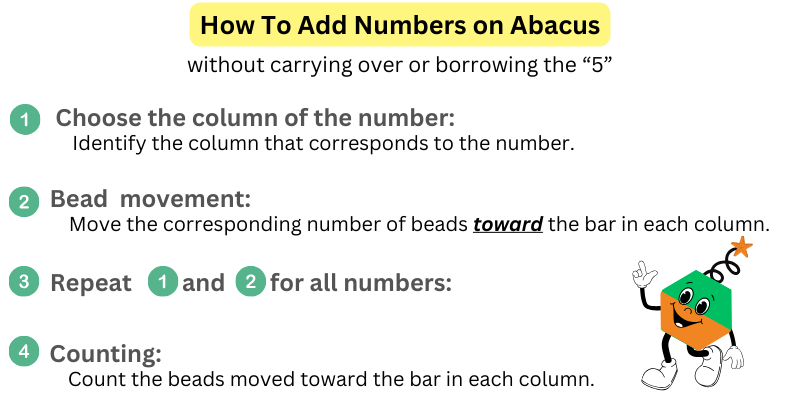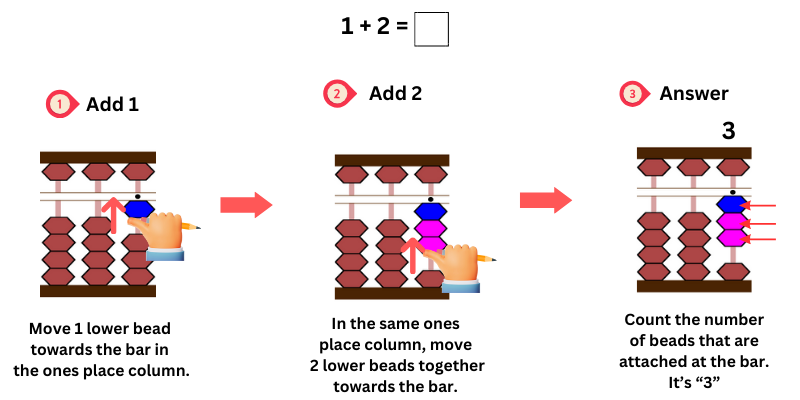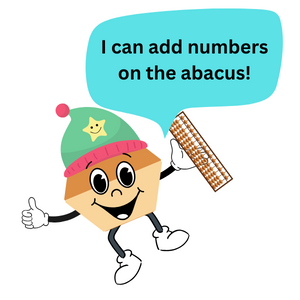
Welcome to Abacus Lesson 4!
In our earlier lessons, we’ve covered the basics of using the abacus. We learned about its different parts, the place value system, hand how to read the numbers on the abacus. We also got familiar with using the thumb and pointer techniques and the rules for their order. By now, you should see the abacus as a tool for calculations, even though it doesn’t display digital numbers And now, we’re all set to dive into addition and subtraction operations.
In this lesson will walk you through simple addition, without getting into the complexities of carrying over. You’ll get a closer look at using your fingers – the thumb, pointer, and thumb+pointer – building on what you learned in our last session.



Let’s go through some examples using the table above. You’ll see how we add on the abacus by finding the right column,moving beads, doing it again, and counting the beads to get the sum.
Simple addition in the ones place column
Example 1: [1 + 2]
- Choose the colum of the first number: The first number is 1. It’s a single digit number, so we will add 1 in the ones place column.
- Bead Movement: Move 1 lower bead up toward the bar.
- Choose the column of the second number: The second number is 2. It’s also a single digit number. We will add 2 in the same ones place column.
- Bead Movement: Move 2 lower beads up toward the bar.
- Count the number of beads attached at the bar to determine the sum. Each lower bead has a value of 1, and 3 lower beads are attached to the bar. Thus, the answer is 3. 1+2 = 3.


Example 2: [5 + 3]
- Choose the colum of the first number: The first number is 5. It’s a single digit number, so we will add 5 in the ones place column.
- Bead Movement: Move the upper bead down toward the bar.
- Choose the column of the second number: The second number is 3. It’s also a single digit number. We will add 3 in the same ones place column.
- Bead Movement: Move 3 lower beads up toward the bar.
- Count the number of beads attached at the bar to determine the sum. There are the upper bead 5 and 3 lower beads attached at the abar. Thus, the answer is 8. 5+3 = 8.


Example 3: [2 + 7]
- Choose the colum of the first number: The first number is 2. It’s a single digit number, so we will add 2 in the ones place column.
- Bead Movement: Move 2 lower beads toward the bar.
- Choose the column of the second number: The second number is 7. It’s also a single digit number. We will add 7 in the same ones place column.
- Bead Movement: Move 2 lower beads and the upper bead toward the bar.
- Count the number of beads attached at the bar to determine the sum. There are the upper bead 5 and 4 lower beads attached at the abar. Thus, the answer is 9. 2+7=9.


Video Lesson for Simple Addition

Simple Addition with 3 Numbers
When adding more than two numbers on the Japanese abacus, you do the same thing as when you’re adding just two numbers. For each number, find its column and move the right number of beads toward the bar until there are no more beads left to add. Keep doing this for each number. Then, when you’re finished, count up all the beads attached at the bar to get the total sum.
Example 4: [3 + 5 + 1 ]
- Choose the colum of the first number: The first number is 3. It’s a single digit number, so we will add 3 in the ones place column.
- Bead Movement: Move 3 lower beads toward the bar.
- Choose the column of the second number: The second number is 5. It’s also a single digit number. We will add 5 in the same ones place column.
- Bead Movement: Move the upper bead toward the bar.
- Choose the column of the third number: The third number is 1. It’s also a single digit number. We will add 1 in the same ones place column.
- Bead Movement: Move 1 lower bead up toward the bar.
- Count the number of beads attached at the bar to determine the sum. There are the upper bead 5 and 4 lower beads attached at the abar. Thus, the answer is 9. 3+5+1=9.


Practice Questions
Work through all the worksheet or video problems multiple times until you feel confident with simple addition. Pay attention to using the correct fingers for each operation. Consistent practice will enhance your skills.
Click the green button below to access the printable worksheets.
Access to the Practice questions video below.


In this lesson, we learned how to add simple numbers using the abacus.
It’s pretty cool how the beads represent numbers when we slide them towards the bar.
Remember, the abacus works with place values, so it’s crucial to pick the right column for the number you’re adding. We kept things simple today by not dealing with borrowing or carrying over.
Next up, we’ll get into subtraction, again keeping it straightforward without any borrowing. We want to give you a clear idea of how addition and subtraction work with the abacus: sliding beads towards the bar means adding, while moving them away means subtracting. Ready to dive into subtraction in our next lesson? Let’s do it!
